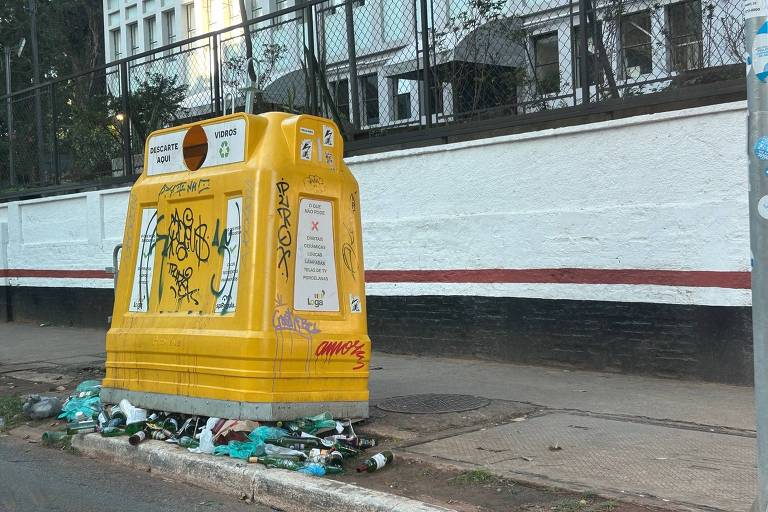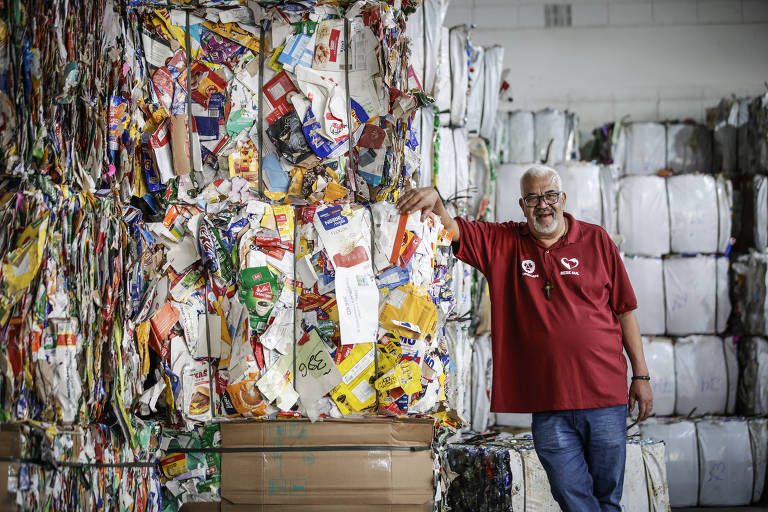Glass collectors in SP suffer from low adhesion and vandalism

Large yellow containers have been spreading across the city of São Paulo in recent months to boost the selective collection of glass for recycling .
Called voluntary delivery points (PEV), they follow the European model and currently total 608 collectors located in locations identified by the city government as major producers of this type of waste.

A separate and exclusive collection system for glass is justified due to the different specificities of this material.
Glass is 100% recyclable and 100% circular , meaning that one bottle can be transformed into another of equal quality infinitely. If broken, it is dangerous for waste pickers, but it can be disposed of directly in containers without risk. Landfilling glass is an expensive process, as municipalities pay for landfills by weight of waste.
In order to work, however, the PEV model requires the engagement of the population, who need to take the glass packaging to one of these containers . Successfully implemented in cities such as Florianópolis (SC), glass containers have faced some challenges in São Paulo.
Placed on sidewalks and squares, some of them are torn down or set on fire a few days after being installed. In some cases, they even face refusal from nearby residents, who request their removal.
"Our biggest problem today is vandalism," explains Mauro Haddad, director of SP Regula, the regulatory agency for public services of the City of São Paulo. "We replaced the container in front of the SP Regula building and, within two days, it had already been vandalized," he says. "In the Sé region, there were about 30 containers that we had to remove because of vandalism. Sometimes they knock them over to see if there is other material inside, other times they set them on fire. It's not an accident."
In Europe, the use of glass PEVs has led several countries to achieve almost 90% glass recycling. In Brazil, recycling of the material has reached 25%, which means that 75% of the glass discarded in the country is landfilled or has even more inappropriate destinations, such as landfills, rivers, landfills and ditches.
Glass is the only recyclable material subject to a federal decree that establishes responsibilities and targets, organizing the players in the sector. Plastic, aluminum and paper have been waiting for the same regulation for years.
"Our culture is still one of sweeping the problem under the rug, and not everyone doing their part and getting involved," says Lucien Belmont, president of the Brazilian Glass Industry Association (Abividro).
He believes that the PEV model is based on environmental education and public participation. And, in Europe, it is financed by a small fee included in the price of all glass products, which is transferred to a management entity that works with municipal collection.
"The logic is to incorporate the cost of externalities into the value of the material and force everyone to work in the same direction. In Brazil, you only pay for the commercial value of the waste," he explains.
The commercial value of glass for recycling in Brazil is low because it is a material made from cheap and abundant raw materials in the country. On average, a kilo of glass costs R$0.20, according to the 2024 Recycling Yearbook.
"We still treat waste in an amateurish way in Brazil, and this is one of the biggest expenses for municipal budgets," adds Belmont.
Last year, the administration of Mayor Ricardo Nunes (MDB) renewed for the next 20 years and without bidding the two billion-dollar contracts for the city's garbage collection service, with companies that have shared the concession since 2004.
To continue operating the system until October 2044, Ecourbis will receive R$40 billion to serve the east and south zones, and Loga, for R$38 billion, will continue to be responsible for the northwest sector — the west, north and center regions of the capital.
According to Haddad, from SP Regula, the renewal of contracts had as its first milestones the universalization of selective waste collection and the institution of the segregated glass collection operation.
Data from SP Regula points to an increase in collection from an average of 15 tons per month in 2024 to 95 tons per month in 2025. Even so, the number is considered low.
Abividro estimates that each collector should collect an average of 800 kilos of glass per month to justify the operation. The current average is 155 kilos per month.
The collection is done in a specific truck that removes the loaded collector and puts an empty one in its place. It is then taken to one of the city's two mechanized sorting centers, where it is unloaded directly into a dumpster, from where it is sent to the buyer.
The profits obtained from the operation are returned to recyclable material collectors through a fund that benefits the 29 cooperatives that have agreements with the city government.
According to Telines Basílio do Nascimento Junior, Carioca, president of Cooperacaps , which works in the city's mechanized centers, the volume of glass collected has more than doubled in the last six months.
In Florianópolis, where the system has existed since 2014, Mayor Topázio Neto (PSD) announced that, with the glass containers, the city saves more than R$1 million per year in landfilling and that the glass sent for recycling generates annual revenue of R$1.2 million.
The program in the capital of Santa Catarina was expanded in partnerships such as the one made with the company Verallia, one of the largest global producers of glass packaging that maintains segregated collection operations in 46 cities in seven states in Brazil.
Named Vidro Vira Vidro, and carried out in partnership with glass recycler Massfix, the program saw a 40% increase in glass collection in one year, reaching the 5,000 tonne mark in 2024, or 416 tonnes per month.
According to Quintim Testa, CEO of Verallia for Latin America, the glass collected in Brazil in its dark green containers is made up of 50% beer bottles, 30% wine and other beverage bottles and 20% other packaging.
"Collection is increasing, but it takes time, environmental education of the population and persistence," explains Testa. "The circularity of glass can benefit everyone."
uol






